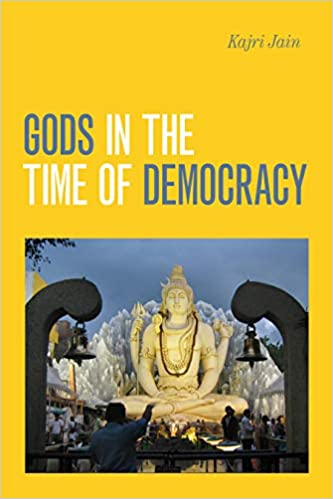
In the post-liberalized landscape of India, Kajri Jain’s book Gods in the Time of Democracy, published by Duke University Press in 2021, offers a tantalizing glimpse into the complex religiopolitical layers of the emergence of colossal statues. She notes that the statues in her book are to be found in Theme parks, memorials, landscaped spaces, on beaches and even on highways. She argues that these images of the Gods represent both a break from the traditional Hindu deity worship strictly controlled by the Brahminical mediators and a coming together of new ones. They include local capitalists, politicians, statue-makers, and multiple religious and semi-religious functionaries. Some of the statues also articulate the nature of nationalism and speak volumes of the secular credentials of the Indian state.
The author prefers to make use of ‘icon’ to locate the various processes which are involved in the statue making and installation process and what it symbolically represents. She cleverly charts her path through the midst of the twin categories of religious and secular to discuss both the socio-political function and devotional aspects of these images. Especially, with regards to how these have re-established hegemonical counter-aesthetical iconographies in the public space.
She uses the concept of “sensibility” as a means of identifying the political affiliations that art and aesthetics produce with regard to these statues. She traces the network and circuits in a modern Brahmanical regime where modalities of purification and control are altered.These include the local print media, the celebration of festivals, patronage and electoral politics and landscapes which interact and form what she terms an ‘assemblage’ in this regard.
In her first chapter, she begins to discuss the material used in these statues, which ranges from concrete to fibreglass and their importance in the statue-making process which are in continuation with modern architecture and modernity at large. The second chapter builds on the popularity of religious statues in public places. The author here argues that despite dams and factories that were once celebrated as ‘temples’ or ‘magic of the state’, there has been a constant tussle of recognition of the religious and the ethnic in India.
She contends that the spread of mimetic (emphasis Taussig) statues, temples, and pictures in print media has usually emerged not only as native responses to colonialism but also as a declaration of a Hinduized pubic sphere. However, she also looks at debates of aesthetics that rose through the contestation of who held control of the public sphere, and the kind of socio-political movements that had emerged from it. This is largely explained through the criticism that Chief Minister Mayawati had received for building exponential Dalit iconographies. Other examples include the contestations and interactions by which the Vivekananda Rock Memorial and the statue of the Tamil poet Thiruvalluvar came up off the coast of Kanyakumari.
This entire logos of art informs people’s perception and vice-versa is according to the author the study of ‘iconopraxis’. According to her the oscillations between exhibitionary and cultic value of art is where we may be able to answer the complex questions which entangle modernity, secularism and religion. In the chapters that follow she tries to locate the oscillation referred to earlier through the idea of ‘automobility’, a concept the author introduces to talk about the links of statue making with the proliferation of mobility.
The discussion is continued in the final chapter on sites of statue building in the Indian diaspora living in Trinidad and Mauritius. The discussion is largely based on their diasporic identification with India and more specifically with Hindu symbols of belonging and power. She closes the discussion by drawing upon the colossal ‘Statue of Unity’ by building on the current regime’s outlook which at once is characterized by business-led growth models linked to the Indian business class diasporas.
The closing chapter of the book makes a case for understanding why large-scale statutes have to speak about politics and democracy. The book charts a fascinating journey in which many scalar relations between polity and politics are well documented through the locus of statue making. However, I must mention a few shortcomings that I found in my reading of the book. One of the major criticisms that I have is to do with the fact that despite the claim of bio-politics featuring as one of the core ideas, it doesn’t feature in the arguments in any major way. Second, the work is an art-historical narrative rather than a serious anthropological exercise. These do not take away from the important fact that the book asks the right question, “Why make statues at all?”.
***
Abir Lal Mazumder is a Research Fellow with the Anthropological Survey of India.